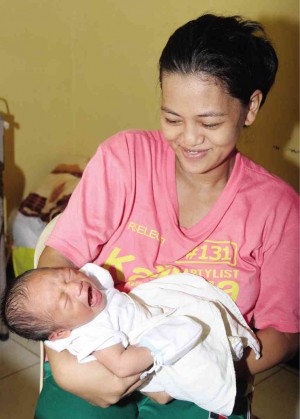100 millionth babies in Baguio, Cordillera, Pangasinan

PAMELA Pedronio shows off her son, John Paul, who was born on July 27 at 12:20 a.m., making him Pangasinan’s symbolic “100 millionth Pinoy.” GABRIEL CARDINOZA/INQUIRER NORTHERN LUZON
BAGUIO CITY—Claire Jiliene Avila of Baguio City was born a minute later than Chonalyn Cabigayan, the 100 millionth baby of the country, but she, too, shares that title, along with Severine Heiress Longbuan of Benguet province, Janaira Hormelia Lazaro of Kalinga province and John Paul Pedronio of Pangasinan province.
For a newborn baby to qualify as a symbolic 100 millionth baby, he or she should have been delivered in a government health facility on July 27 at 12:06 a.m. Babies born seconds or minutes later also qualify, officials of the Department of Health (DOH) and the Commission on Population (Popcom) said.
John Paul was born at 12:20 a.m. at Pangasinan Provincial Hospital in San Carlos City.
Severine Heiress was born to Jaimee Catbagan and Florendo Longbuan at 12:15 a.m. at Benguet General Hospital in La Trinidad town while Janaira Hormelia was born at 12:30 a.m. at Kalinga Provincial Hospital in Tabuk City.
Baguio’s Claire Jiliene was born to Joanne Christine Avila, 21, at 12:07 a.m. on Sunday.
Nelson Garlejo, her father, was surprised by the attention that his daughter garnered at Baguio General Hospital and Medical Center (BGHMC). “I did not know there was a countdown,” said Garlejo, who is a contractual employee of Philex Mining Corp.
Claire Jiliene and the 100 millionth babies are special “like all individuals and are entitled to quality care,” which is what the 100 millionth baby program of the Popcom is trying to express, said Rosa Fortaleza, Popcom Cordillera director.
But these newborns also serve as warnings to the government that the country does not have enough resources for 100 million Filipinos, Fortaleza told reporters here on Monday.
“Our population is growing very fast, based on the 2000 and 2010 census,” she said.
In 2000, the Philippines had 92 million people and this population grew at the rate of 2 percent, Fortaleza said, indicating that each year, 1.9 million newborns are added to the Philippine population.
The 100 millionth babies are meant to remind the government that it now needs to address their needs in an environment where “it has yet to fulfill the needs of the older members of the population,” she said.
“They tell us that we all have responsibilities to the community,” Fortaleza said.
The children who share the 100 millionth baby title were born in public medical facilities, which are confronted by the fact that they now serve an even bigger number of potential patients, said Dr. Manuel Quirino, head of BGHMC’s emergency medical department.
“More people mean that we have to think of ways to build more rooms and buy more health facilities,” Quirino said.
The newborns also validate the government’s efforts to enforce the Responsible Parenthood and Reproductive Health Act of 2012, the officials said.
The Aquino administration has fought a long, drawn-out battle in the Supreme Court, which ruled on April 8 that the reproductive health law is constitutional during the court’s summer sessions here.
The birth of baby boy John Paul Pedronio raised Pangasinan’s population to a projected 3,052,623 people this year, up from its 2,779,000 population in 2010.
Ellsworth Gonzales, Pangasinan provincial population officer, said the province had a population growth rate of 1.34 percent, lower than the 1.7-percent national growth rate.
Pangasinan’s 100 millionth baby’s delivery was smooth, which exemplifies the province’s reduced maternal mortality ratio, or the measure of maternal deaths, from 68 per 100,000 live births in 2009 to 48.52 per 100,000 live births in 2014.
This is lower than the 52 per 100,000 set by the United Nations’ Millennium Development Goals (MDG) for 2015. Vincent Cabreza and Gabriel Cardinoza, Inquirer Northern Luzon














